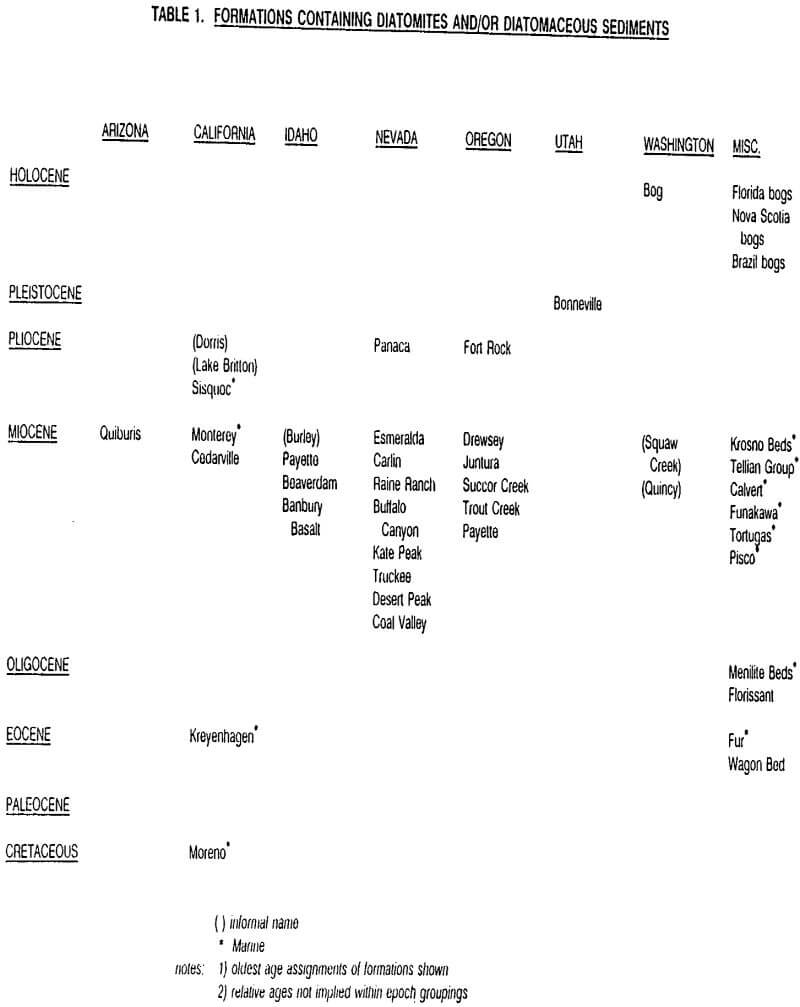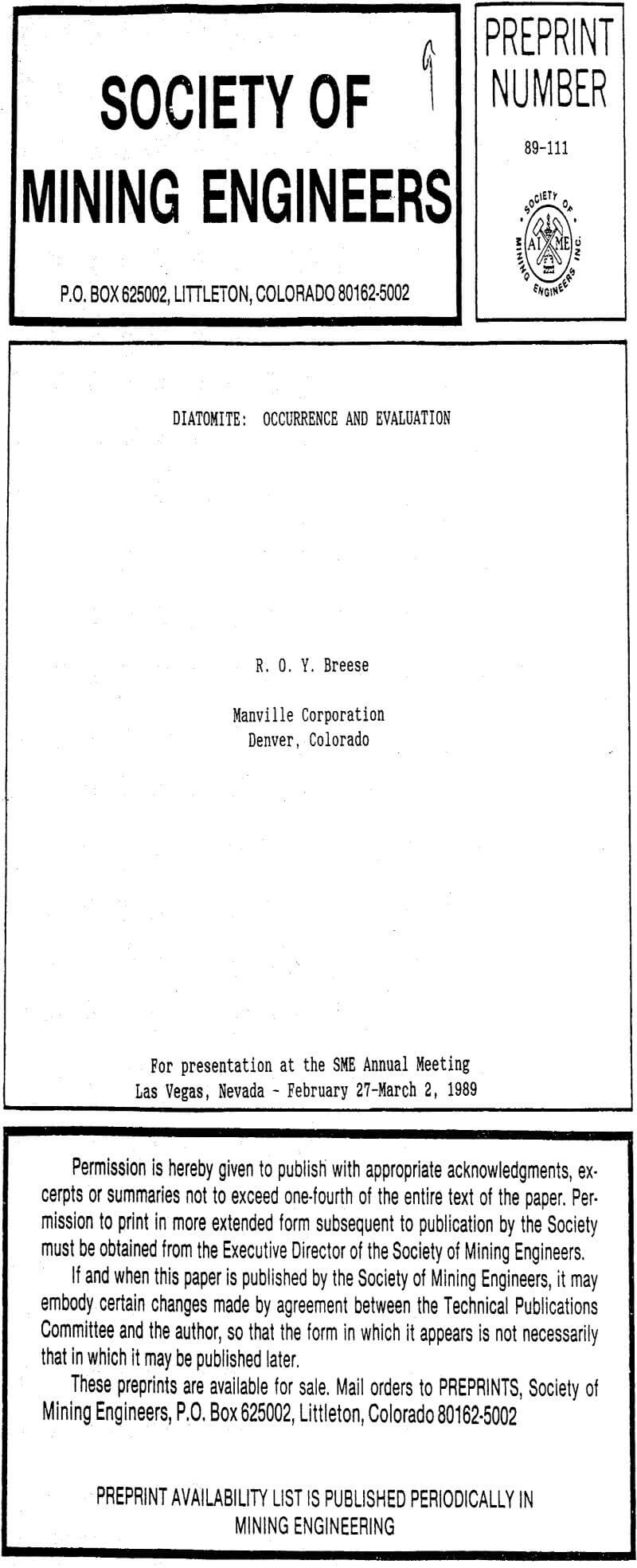Worldwide, diatomites occur within Tertiary to Recent lacustrine and marine sediment facies (see Table 1). Geologically, the oldest marine and lacustrine diatoms predate the effusive blooms of the post Oligocene depositional period, and are respectively found within Cretaceous and late Eocene sediments. In the U.S., marine species are found in rocks as old as the California’s Cretaceous Moreno Shales. The oldest non-marine diatoms observed in the U.S. are found as a well developed assemblage within late Eocene sediments of Wyoming.
Deposits of diatomite reflect stability of environmental and depositional conditions as well as optimum preservation environment. While depositional rates vary, typical varve thicknesses suggest yearly accumulations of no more than several millimeters of compacted sediment. Strata of significant thickness and high purity, therefore, indicate prolonged environmental conditions that favored high diatom productivity and that were free of continuous and significant elastic contribution or chemical precipitation. Geological preservation of the soft sediments requires protection from erosion, such as by overlying volcanics, and it also demands that they are not subjected to geological conditions which promote dissolution or diagenetic alteration to chert, porcelanite or quartz such as deep burial, exposure to high temperature and exposure to alkaline ground water.

Marine environments that are favorable for deposition of nearly pure diatom accumulation exist in submerged coastal basin areas and shelves that are isolated from significant sources of elastic contribution and that are adjacent to areas of upwelling where waters are nutrient and silica enriched, and biologically productive. Such areas occur today along the Californian, Peruvian and southwest African coastlines (Soutar, et.al., 1981 and Lisitsyn, 1967). Seawater rich in both nutrients and silica have been observed to contain as many as 1 million diatom cells/ml. (Tappan, 1980) and diatomites such as those in the Monterey Formation have been observed to contain as many as 21 million frustules/cubic inch (Barron, 1986).
Tertiary marine deposits are commonly found along uplifted Pacific Rim coastlines and are associated with interbeds of volcanic ash, clay and elastic sediments. Thick marine deposits occur in the Miocene Monterey Shales in Santa Barbara and Kern Counties, California, in the Miocene Tortugas Formation of Baja, Mexico, in the Miocene Pisco and Zapayal Formations along the Peruvian coast, and in the Miocene Funakawa Formation of Northern Japan. Other marine diatomites and diatomaceous sediments occur in Paleocene sediments in Poland, in the Paleocene- Eocene Fur (Moler) Formation of Denmark, in the Miocene Tellian Group (Beida Stage) of Algeria, in the Miocene Calvert Formation of Maryland and Virginia, in the Hawthorne Formation of Georgia, and within Tertiary sediments in Spain, South Korea, Chile, Hew Zealand and Java.
Lacustrine environments typically exhibit more variability than marine environments regarding salinity, pH, temperature and nutrient content, but they can produce diatomite sections often 10’s of meters or more in thickness. Deposits commonly occur in Miocene to Recent volcanic environments and are associated or interbedded with volcanic rocks and sediments. The association is clearly demonstrated by deposits within the lake sediments of caldera coats (Trout Creek Mountains, Oregon), lava dammed rivers (Terrebonne, Oregon), in the subsiding valleys of the basin and range, such as occurs throughout western Nevada and elsewhere in the lake sediments of volcanic maars, (common in the Massif Central of France). Less common in the western U.S. are bog or shallow pond deposits that are found in Holocene to Recent volcanic and non-volcanic, marshy lowland terrains. The thick diatom accumulations which are common in the Tertiary sediments of the western states reflect exceptional availability of silica in large quantities from external sources such as runoff, ground water seepage, hot or cold springs and/or from internal regeneration of silica released from bottom sediments (Hurley and Kenover, 1985). Much of the silica requirement undoubtedly is supplied by groundwater percolating through silica rich volcanic rocks and sediments. Living planktonic communities can achieve concentrations of 1000-4000 cells/ ml., and the density of benthic associations can be as high as several million/square cm. (Bradbury, 1988). As many as 200 million cells per cc. are reported in the sediments of Tulelake, California (Bradbury, 1988), and as many as 1 billion cells have been reported to comprise a dry gram of lacustrine diatomite (Tappan, 1980). Given the large size of many western deposits, densities as high as these illustrate the immensity of the diatom biomass and the silica requirement through time.
Well-known lacustrine deposits (see Table 1 and Figure 1) occur in the Neogene Esmeralda, Truckee, Desert Peak, Kate Peak, Carlin, and Panaca Formations in Nevada, in the Fort Rock, Juntura, Succor Creek, and Trout Creek Formations of Oregon, and in the Squaw Creek and Quincy portions of the Yakima Basalt of Washington. Diatomites are also present in the Neogene Quiburis Formation of Arizona, and in the Banbury Basalt, Payette and Beaverdam Formations in Idaho. Diatomites and diatomaceous sediments of Pleistocene and Recent age occur in Bonneville and Pyramid sediments within Utah and Nevada, in bog deposits of western Washington and Alaska, and elsewhere in the bog deposits of Florida, Nova Scotia, Western Australia and Eastern Brazil.
